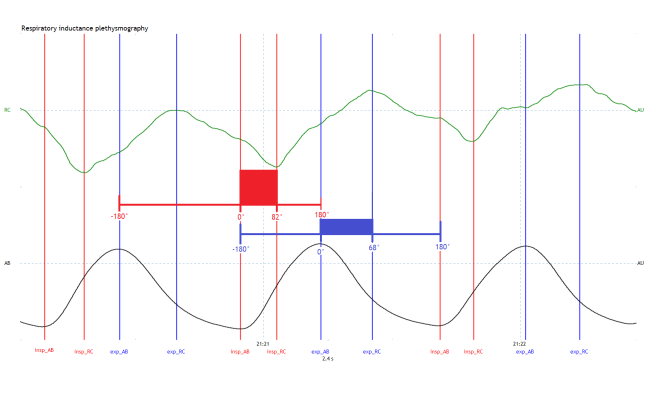Phase shifts
Overview
The phase angle is a measure to quantify the severity of airway obstruction, since upper airway obstructions increase the thoraco-abdominal asynchrony (see [Rimensberger2015] p.354).The phase shift is calculated from a phase delay between expansion of the abdomen and rib cage. This delay of movements is expressed in phase angels ranging from 0° (no delay = in-phase) to 180° (out-of-phase), see [Rimensberger2015] p.988, [Prisk2002], [Newth2005] and [Hammer2009].
The following figure shows a RC- and an AB signal with the respective inspiratory- and expiratory onsets.

Since RC and AB RIP signals are no perfect sinusoids most of the time, the inspiratory phase angle and expiratory phase angle should be determined separately.
The inspiratory detection periods are defined as segments from an exp_AB to the next exp_AB. The expiratory detection periods are defined as segments from an insp_AB to the next insp_AB. Each inspiratory and expiratory detection period is divided into two segments by insp_AB and exp_AB, respectively, both segments range from 0° to 180°.
Explaination of different phase shift cases:
-If AB expands before RC and AB decreases before RC (like in the figure), both inspiratory and expiratory phase angles are greater than 0°.
-If RC and AB expand and decrease synchronously, both inspiratory and expiratory phase angles are 0°.
-Complete asynchrony (paradoxical movements) results in a phase angle of 180°.
-If RC expands and decreases before AB expands and decreases, both inspiratory and expiratory phase angles are less than 0°.
Details
The phase shift is calculated in the RIP app for each respiratory cycle during the inspiration as:
In this equation breath length is calculated as:

An error margin of 5°<x<355° is used in case the RC comes just before AB, thus causing the phase to become around 360°.
